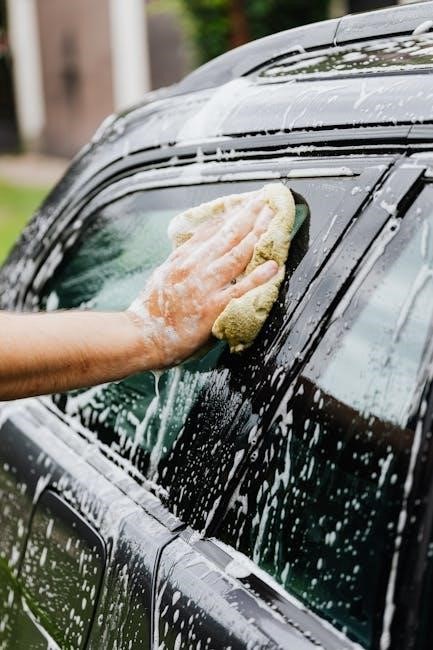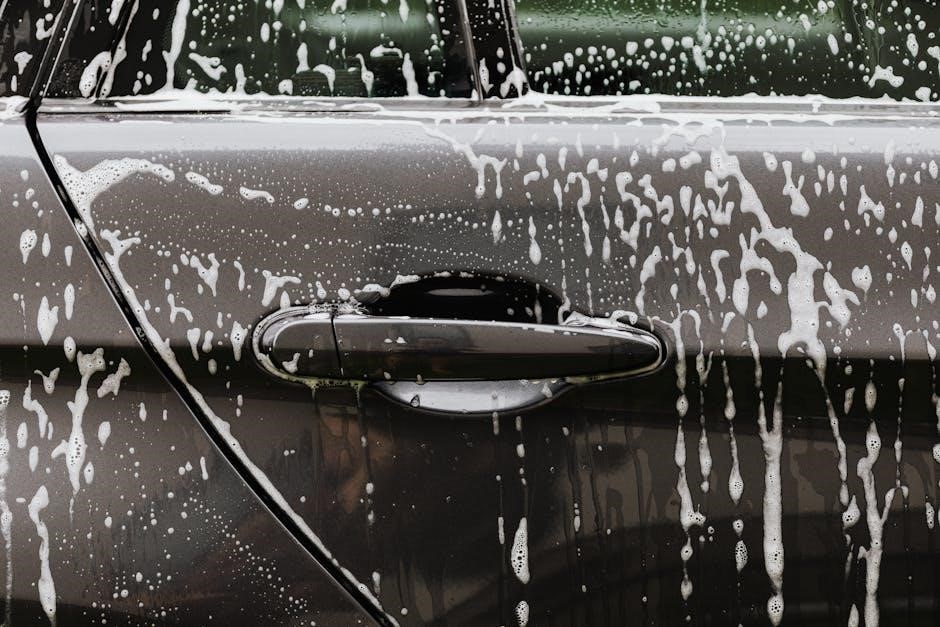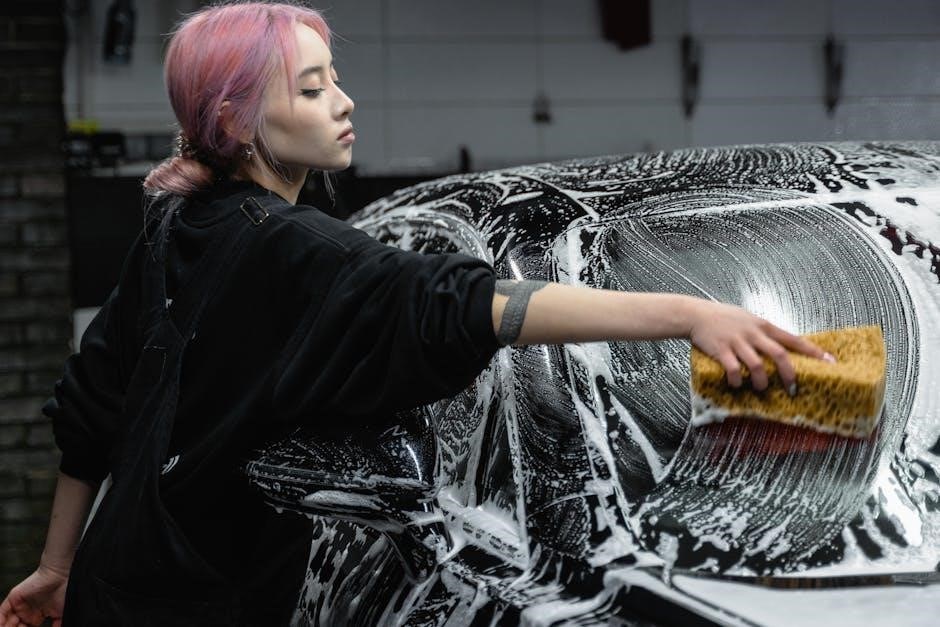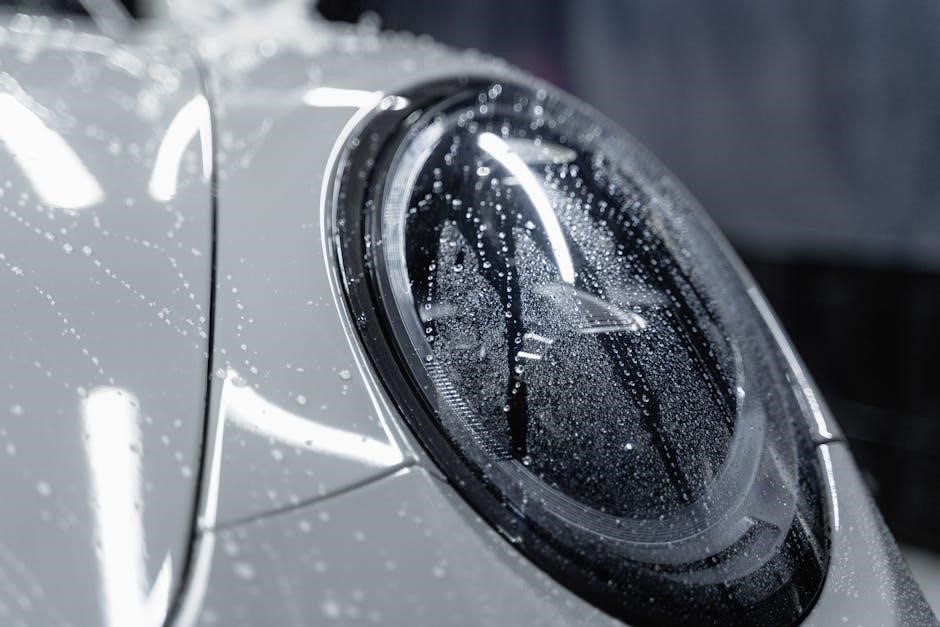Auto detailing is a meticulous process that transforms vehicles, restoring their appearance inside and out. It goes beyond a simple car wash, involving precise techniques and products to achieve showroom-like results, ensuring both aesthetic appeal and long-term protection for your car.
1.1 What is Auto Detailing?
Auto detailing is a comprehensive process aimed at restoring and enhancing a vehicle’s appearance, both inside and out. It involves meticulous cleaning, polishing, and protective treatments to achieve a showroom-like finish. Detailing addresses every aspect of the car, from the paintwork and wheels to the upholstery and glass surfaces. Unlike a standard car wash, detailing focuses on precision and attention to detail, ensuring every imperfection is addressed. Its primary goal is to preserve the vehicle’s condition, maintain its value, and create a pristine environment for drivers and passengers. Regular detailing also protects surfaces from environmental damage, ensuring long-term durability and aesthetic appeal.
1.2 Importance of Regular Detailing
Regular detailing is essential for maintaining a vehicle’s condition and preserving its value. It prevents the buildup of contaminants that can damage paint and surfaces over time. By addressing minor imperfections early, detailing helps avoid costly repairs. A clean and well-maintained interior also enhances comfort and hygiene, while a polished exterior protects against environmental elements. Regular detailing not only boosts a car’s aesthetic appeal but also ensures its longevity, making it a worthwhile investment for any car owner. Consistent care can significantly extend the life of both interior and exterior components, keeping the vehicle looking and feeling new for years.

Exterior Car Detailing
Exterior car detailing transforms the vehicle’s appearance by removing contaminants, correcting paint imperfections, and applying protective coatings, ensuring a pristine finish and long-term protection from environmental elements.
2.1 Pre-Wash and Inspection
Pre-wash and inspection are crucial first steps in exterior detailing. A thorough visual inspection identifies contaminants and damage. Rinsing the vehicle removes loose dirt, preventing scratches during washing. This step ensures a safer, more effective cleaning process and helps detailers address specific areas needing attention, such as tar spots or bug splatters.
2.2 Wheels, Tires, and Arches Cleaning
Cleaning the wheels, tires, and arches is a detailed process that enhances the vehicle’s exterior appearance. Start by applying a specialized wheel cleaner to remove brake dust and grime. Scrub the wheels with a brush to reach tight spaces. For tires, use a tire cleaner to eliminate grease and dirt, then rinse thoroughly. Finally, dress the tires and wheel arches with protective products to give them a polished look and shield them from future contamination, ensuring a pristine finish that complements the rest of the car’s detailing.
2.3 Snow Foam and Shampoo Application
Applying snow foam is the first step in deep cleaning the vehicle’s exterior. This pre-wash treatment softens and loosens dirt, tar, and bug splatters, making it easier to remove stubborn contaminants without damaging the paint. Use a snow foam lance or spray bottle to evenly coat the car, allowing it to dwell for a few minutes. Follow with a car shampoo using a microfiber mitt or sponge, working from top to bottom to prevent dirt from spreading. Rinse thoroughly with a hose or pressure washer to ensure a clean surface for further detailing steps, like decontamination and polishing.

2.4 Decontamination and Claying
Decontamination removes stubborn contaminants like tar, overspray, and iron deposits, which aren’t eliminated by washing alone. Use a dedicated decontamination spray to dissolve these substances, ensuring a clean surface for further detailing. After rinsing, claying is applied to remove remaining impurities and smooth out the paint. This step is crucial for achieving a flawless finish and preparing the vehicle for polishing. Regular claying helps maintain the paint’s integrity and ensures protective coatings adhere effectively, preserving the car’s exterior for years to come. This process is essential for a professional detailing outcome.
2.5 Polishing and Paint Correction
Polishing and paint correction are advanced techniques to restore and enhance a vehicle’s paintwork. This process removes imperfections like scratches, swirl marks, and oxidation, revealing a smooth, glossy finish. Using a dual-action polisher or rotary tool with varying abrasives, detailers progressively refine the paint. A one-step polish can achieve minor corrections, while multi-step processes tackle deeper flaws. Final buffing ensures even results. Protective coatings like wax or ceramic are then applied to maintain the finish. This step is vital for achieving showroom-quality paint and protecting it from environmental damage, ensuring long-lasting beauty and durability for the vehicle’s exterior.
2.6 Drying and Protective Coatings
Drying is the final step in exterior detailing, ensuring no water spots remain. Microfiber towels or air blowers are used to gently remove moisture from paint, windows, and trim. After drying, protective coatings like wax, ceramic, or paint sealants are applied to shield the paint from UV rays, dirt, and environmental contaminants. These coatings enhance gloss and provide long-term protection. Regular reapplication maintains the protective barrier, keeping the vehicle looking pristine and safeguarding its exterior surfaces from damage. Proper drying and coating ensure a showroom finish and extend the lifespan of the car’s paint and clear coat.

Interior Car Detailing
Interior detailing focuses on deep cleaning and restoring the car’s inside, including vacuuming, cleaning surfaces, sanitizing, and protecting materials to maintain a fresh, hygienic, and luxurious environment.
3.1 Vacuuming and Removing Large Debris
Vacuuming is the first step in interior detailing, focusing on removing dirt, dust, and debris from carpets, seats, and crevices. Using a high-quality vacuum with various attachments ensures thorough cleaning. Start by eliminating large debris like coins or crumbs, which can damage upholstery. Pay attention to hard-to-reach areas, such as between seats and under floor mats. This step sets the foundation for deeper cleaning and prevents scratches during subsequent processes. Regular vacuuming maintains the interior’s cleanliness and prolongs the lifespan of the materials.
3.2 Cleaning Hard Surfaces and Upholstery
Cleaning hard surfaces and upholstery is crucial for a detailed interior. Use specialized brushes and gentle cleaners to wipe down dashboards, consoles, and doors, ensuring no scratches. For upholstery, apply fabric or leather cleaners, depending on the material, and gently scrub stains. Avoid harsh chemicals that can damage surfaces. Steam cleaning is an advanced method for deep-seated dirt. Regular cleaning prevents dirt buildup and maintains the interior’s freshness. Proper techniques and products ensure a spotless finish, enhancing both comfort and aesthetics for the vehicle’s occupants.
3.3 Sanitizing and Deodorizing
Sanitizing and deodorizing are essential steps to eliminate germs, bacteria, and unpleasant odors. Use UV light sanitizers or steam cleaners for deep disinfection. Apply odor-neutralizing sprays or ozone generators to remove lingering smells. For natural methods, baking soda or essential oils can absorb odors. Regular sanitizing ensures a healthy environment, while deodorizing leaves a fresh, clean scent. These steps enhance comfort and create a pleasant interior atmosphere, making your car a cleaner and more enjoyable space to be in.
3.4 Dressing and Protecting Interior Materials
Dressing and protecting interior materials is the final step in enhancing your car’s interior. Apply dressings to upholstery, leather, and trim to restore their appearance and protect against wear. Use UV protectants on fabrics to prevent fading and fabric guards to repel stains. For leather, conditioners and protectants maintain softness and durability. Regular dressing ensures materials remain vibrant and resistant to damage, preserving the interior’s quality and extending its lifespan while keeping it looking like new for years to come.


Advanced Detailing Techniques
Advanced techniques elevate detailing to expert levels, including paint correction, ceramic coatings, and precision polishing. These methods enhance durability, gloss, and protection, ensuring a flawless finish for your vehicle.
4.1 Paint Enhancement and Buffing
Paint enhancement and buffing are advanced techniques used to restore and perfect a vehicle’s exterior finish. Buffing removes minor imperfections like scratches and swirl marks, while paint enhancement rejuvenates the color and clarity. These processes involve specialized tools and polishes, ensuring a smooth, glossy surface. Regular buffing helps maintain the car’s appearance and protects the paint from environmental damage, keeping it looking showroom-ready for years to come.
4.2 Ceramic Coating Application
Ceramic coating is a advanced protective treatment for your car’s paint. It involves applying a liquid polymer that bonds with the vehicle’s surface, creating a durable, hydrophobic barrier. The process includes surface preparation, applying the coating, and curing it under specific conditions. Ceramic coatings offer long-term protection against contaminants, UV damage, and minor scratches. They also enhance gloss and make maintenance easier by repelling dirt and water. Proper application ensures a sleek, resilient finish that preserves your car’s appearance for years, making it a popular choice for detailing enthusiasts and professionals alike.
4.3 Glass Treatment and Protection
Glass treatment and protection are essential for maintaining clarity and safety. Start with a thorough cleaning using specialized glass cleaners to remove contaminants. Apply a hydrophobic coating or glass sealant to repel water, reducing streaks and improving visibility during rain or snow. This treatment also minimizes UV damage and prevents minor scratches. Regular maintenance ensures long-term protection. For enhanced durability, opt for ceramic-based glass treatments that offer superior resistance to environmental factors. Properly treated glass enhances safety, reduces eye strain, and maintains your car’s aesthetic appeal, making it a crucial step in detailing.
Regular auto detailing ensures long-term protection and enhances your car’s appearance. By following proper techniques, you preserve its value and maintain a pristine condition for years to come.
5.1 Maintenance Tips for Long-Term Protection
To maintain your car’s detailing results, wash it regularly with gentle products and microfiber towels. Apply protective coatings like wax or ceramic periodically. For interiors, vacuum frequently and clean spills immediately. Use UV-protectant sprays on upholstery and dashboards to prevent fading. Avoid harsh chemicals that can damage surfaces. Regularly dress tires and trim to maintain their appearance. Consistency is key to preserving your car’s condition and ensuring long-term protection against environmental elements and wear.